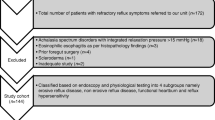Abstract
Background
We assessed the characteristics of symptomatic gastroesophageal reflux disease (sGERD), defined as the presence of symptoms, but no endoscopic findings of reflux esophagitis, in Japanese.
Methods
Sixty-three patients were diagnosed with sGERD, and underwent 24-h esophagogastric pH monitoring (32 men; mean age, 50.5 years). Patients were classified into the following three groups : reflux group (group R), minor reflux group (group MR), and a no-reflux group (group N) by the percentage of time at pH below 4 (group R, 4.0% or more; group MR, 2.0%–3.9%; group N, 0–1.9%). Hiatal hernia was assessed based on the Anatomy-Function-Pathology (AFP) classification, and the shape of the cardia was assessed based on valve factors (V0–V3).
Results
There were 13 patients (21%) in group R, 17 (27%) in group MR, and 33 (52%) in group N. Hiatal hernia was present in 11 patients (85%) in group R, 14 (82%) in group MR, and 22 (67%) in group N. Patients grouped according to presence of V2/V3 (chalasia) accounted for 100% of those in group R, 71% of those in group MR and 70% of those in group N. Hiatal hernia was present in 10 (91%), 10 (83%), and 6 patients (86%) who had 50 or more episodes of esophageal acid reflux per day in group R, group MR, and group N, respectively.
Conclusions
Reflux (percentage of time below pH 4, 4%) was seen in only about 20% of the patients with sGERD, and this percentage of patients with reflux was lower compared to the data reported from the United States and Europe. The percentage of patients who had a hiatal hernia or chalasia was high in all these groups, and this seemed to be a characteristic cause of sGERD in Japanese.
Similar content being viewed by others
References
EMM Quigley (2003) ArticleTitleFactors that influence therapeutic outcomes in symptomatic gastroesophageal reflux disease Am J Gastro-enterol 98 IssueIDSuppl S24–S30 Occurrence Handle10.1016/S0002-9270(03)00012-1
PJ Kahrilas (2003) ArticleTitleDiagnosis of symptomatic gastroesophageal reflux disease Am J Gastroenterol 98 IssueIDSuppl S15–S23 Occurrence Handle10.1016/S0002-9270(03)00011-X Occurrence Handle12644027
T Lind T Havelund R Carlsson O Anker-Hansen H Glise H Hernqvist et al. (1997) ArticleTitleHeartburn without oesophagitis: efficacy of omeprazole therapy and features determining therapeutic response Scand J Gastroenterol 32 974–9 Occurrence Handle9361168
TL Venables RD Newland AC Patel J Hole C Wilcock ML Turbitt (1997) ArticleTitleOmeprazole 10 milligrams once daily, omeprazole 20 milligrams once daily, or ranitidine 150 milligrams twice daily, evaluated as initial therapy for the relief of symptoms of gastro-oesophageal reflux disease in general practice Scand J Gastro-enterol 32 965–73
R Carlsson J Dent R Watts S Riley R Sheikh J Hatlebakk et al. (1998) ArticleTitleGastro-oesophageal reflux disease in primary care: an international study of different treatment strategies with omeprazole Eur J Gastroenterol 10 119–24
JE Richter D Peura SB Benjamin Bo Joelsson J Whipple (2000) ArticleTitleEfficacy of omeprazole for the treatment of symptomatic acid reflux disease without esophagitis Arch Intern Med 160 1810–6 Occurrence Handle10.1001/archinte.160.12.1810 Occurrence Handle10871975
WD Chey (2004) ArticleTitleEndoscopy-negative reflux disease: concepts and clinical practice Am J Med 117 IssueIDSuppl 5A 36S–43S Occurrence Handle15478851
LR Ludell J Dent JR Bennett AL Blum D Armstrong JP Galmiche et al. (1999) ArticleTitleEndoscopic assessment of oesophagitis: clinical and functional correlates and further validation of the Los Angeles classification Gut 45 172–80 Occurrence Handle10403727
J Bancewicz HR Matthews T O’Hanrahan I Adams (1990) A comparison of surgically treated reflux patients in two surgical centers AG Little MK Ferguson DB Skinner (Eds) Diseases of the esophagus Mount Kisco New York 177–80
T Ismail J Bancewicz J Barlow (1995) ArticleTitleYield pressure, anatomy of the cardia and gastro-oesophageal reflux Br J Surg 82 943–7 Occurrence Handle7648116
LF Johnson TR DeMeester (1974) ArticleTitleTwenty-four-hour pH monitoring of the distal esophagus: a quantitative measure of gastroesophageal reflux Am J Gastroenterol 62 325–32 Occurrence Handle4432845
R Fass (2003) ArticleTitleEpidemiology and pathophysiology of symptomatic gastroesophageal reflux disease Am J Gastroenterol 98 IssueIDSuppl S2–S7 Occurrence Handle10.1016/S0002-9270(03)00009-1 Occurrence Handle12644025
AJPM Smout (1997) ArticleTitleEndoscopy-negative acid reflux disease Aliment Pharmacol Ther 11 IssueIDSuppl 2 81–5 Occurrence Handle10.1046/j.1365-2036.1997.116287000.x
SD Martinez I Malagon HS Garewal R Fass (2001) ArticleTitleNonerosive reflux disease(NERD)—is it really just a mild form of gastroesophageal reflux disease (GERD)?(abstract) Gastroenterology 120 IssueIDSuppl 1 A 424
BE Schenk EJ Kuipers EC Klinkenberg-Knol HP Festen EH Jansen HA Tuynman et al. (1997) ArticleTitleOmeprazole as a diagnostic tool in gastroesophageal reflux disease Am J Gastroenterol 92 1997–2000 Occurrence Handle9362179
JE Richter DR Campbell PJ Kahrilas B Huang C Fludas (2000) ArticleTitleLansoprazole compared with ranitidine for the treatment of nonerosive gastroesophageal reflux disease Arch Intern Med 160 1803–9 Occurrence Handle10.1001/archinte.160.12.1803 Occurrence Handle10871974
AJ Cameron (1999) ArticleTitleBarrett’s esophagus: prevalence and size of hiatal hernia Am J Gastroenterol 94 2054–9 Occurrence Handle10.1111/j.1572-0241.1999.01277.x Occurrence Handle10445527
D Sifrim R Holloway J Silny Z Xin J Tack A Lerut et al. (2001) ArticleTitleAcid, nonacid, and gas reflux in patients with gastroesophageal reflux disease during ambulatory 24-hour pH-impedance recordings Gastroenterology 120 1588–98 Occurrence Handle11375941
Author information
Authors and Affiliations
Rights and permissions
About this article
Cite this article
Omura, N., Kashiwagi, H., Yano, F. et al. Characteristics of symptomatic GERD in Japanese patients based on 24-h pH monitoring. J Gastroenterol 40, 791–795 (2005). https://doi.org/10.1007/s00535-005-1629-5
Received:
Accepted:
Issue Date:
DOI: https://doi.org/10.1007/s00535-005-1629-5




